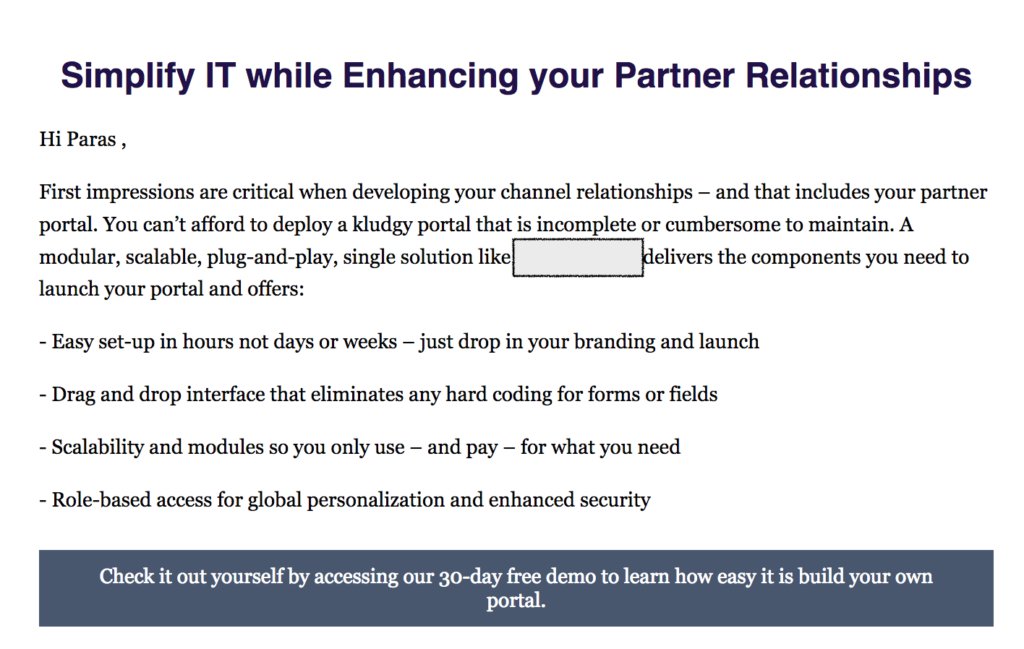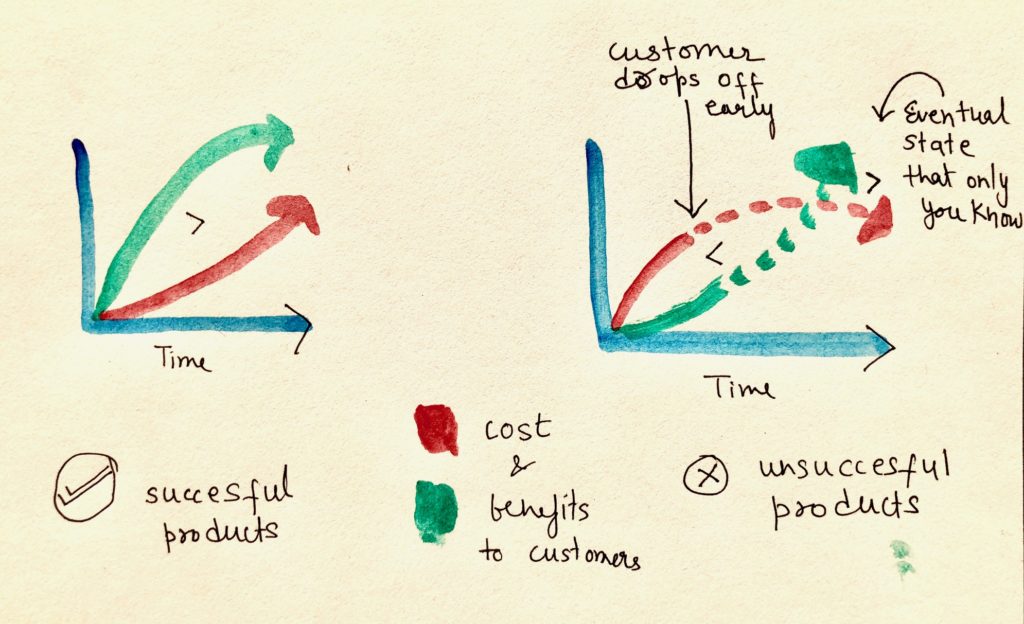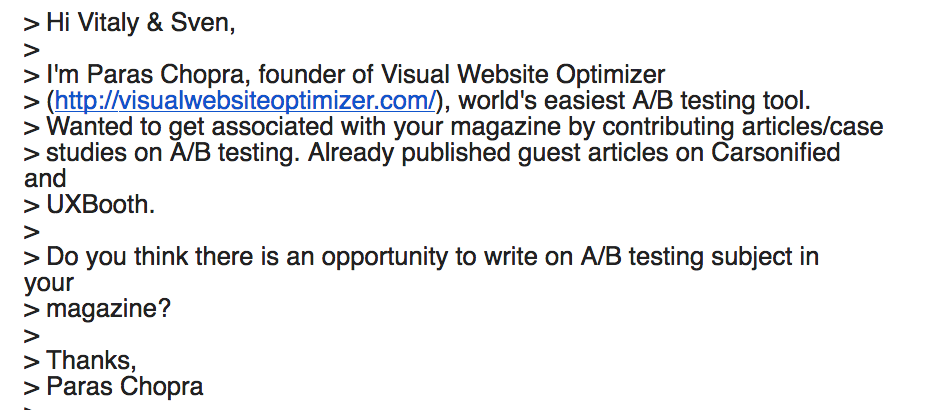Unsolicited emails – the cold emails – have notoriously low reply rates. I’ve seen sales people celebrating 1% reply rates as a huge win. Honestly, isn’t that a bit embarrassing? Only 1 reply out of 100 emails and even that one reply is usually “no, thanks” or “don’t email me again“.
Common justifications for this abysmal reply rate is either people are too busy or simply throwing up hands and saying: “who the hell knows”. I think we can do better than this when it comes to understanding why cold emails don’t get replies.
Your email is a product in itself
First things first, what’s the objective of your cold email? Is it to inform people about your products or services? Is it to create interest in your products? Is it to get an introduction to someone?
Note that, by default, when we’re sitting and drafting emails, what comes to our mind is our objectives – we need more customers, prospects, intros and what not. By default, our brain is in me mode because that’s what jumps to our minds automatically: our goals and wishes.
This bias towards making everything about ourselves is what leads to cold emails that don’t get replies.

I had to find the email above from my spam folder because even Google knows how bad it is (yet, companies don’t stop sending such emails).
If you’re thinking that the email above looks all fine and dandy (because perhaps you’ve been sending similar emails), don’t worry you’re not alone. Writing bad emails is a cognitive bias that you can get better at if you’re aware what’s going wrong.
Bad emails serve your goals, good emails serve recipient’s goals
This blog is called Inverted Passion because I believe that the only way to make other people care about you is to first solve their problems.
5/ If I were to compress my startup advice in <1 tweet, it'll be:
People are busy with their lives. They don’t care that you’re passionate about X. They’ll start caring if your passion makes them passionate about their goals.
(X=your idea, product, ad, blog post, video, etc.)
— Paras Chopra (@paraschopra) March 17, 2018
The tweet above is from my post on MER framework for marketing. The advice applies not just to products, landing pages or banners, but even for emails. People are busy with their lives, daydreaming about what they’ll eat in lunch or reading about Trump or making plans to avoid going to the dentist. The last thing they want is an extra email to reply.
I know you believe that your products and services are the best, and they can change customers’ lives. While this enthusiasm and passion is great, it leads to a dead end because people don’t care what you’re passionate about (they care about their problems and goals). So, while you are drafting your emails mentioning how great your products are, the recipient is wondering when were his TPS reports due.
So in order to get interest in your emails, make emails about the recipient’s goals.
- If you want an intro from someone, think and highlight what goals can the recipient achieve by introducing you in his/her network. Does s/he care about looking cool? Does s/he genuinely want to help a friend? Address their motivations, and don’t make the email about you or your needs.
- If you want a business meeting with someone, research what typical responsibilities a person what that title/role has and what problems do they face. Highlight their goals and problems in your email, not your solution.
Good emails require minimal effort from recipient, bad emails overwhelm them
When people come across a product or a landing page, they have zero previous experience to guide whether all their effort spent reading and exploring is going to be worth it. In absence of a proof (like a brand or an intro from someone they know), they default to giving you minimum attention. Think about your own behavior online. What do you regret more: not spending enough time going through all marketing messages in detail OR missing a chance to use a product or service that you could anyway Google and find out?
As I mentioned in my earlier article on applying prospect theory to product design, the cost v/s benefit analysis in customers’ mind goes something like this:

When the recipients don’t even know you and are busy with their lives, your email is an extra task for them. You cannot expect them to re-prioritize their lives (say, give you a meeting, or sign up for your product) based on your one email.
That’s what’s wrong with this email that I received.

So, some business manager is in the town and I should take out time to meet him so that he can meet his sales quota? If I were an engineering manager and if I wanted a QA service, why can’t I find it myself? What’s in there for me to meet this dude?
In addition to overreach in what they ask from the recipient (me), the email above is also an example of mismatch in motivation. Why would you email about QA services to CEO/Founder? Address my goals, make it easy for me to respond and I’m very highly likely to reply.
There's an art to getting help from other people:
– Keep it specific. Respect people's time
– Do your research. Ask them what they haven't been asked before publiclyPeople with experience are busy, so pin pointed questions that they can answer in <2 minutes is your best shot.
— Paras Chopra (@paraschopra) March 21, 2018
If you want to write emails that get replies, keep them short, specific and ask for minimum effort from recipient. Here’s the one that got me an article on A/B testing in Smashing Magazine, back in 2010 when I was starting VWO.

I don’t mean to brag (maybe I do), but notice: a) it’s short; b) it builds trust (that I’ve written previously); c) it asks a specific ‘Yes’ or ‘No’ question that takes 10 seconds for them to reply.
Not following up on unreplied emails is not doing your job well
Suppose you send me an email, I open it but your email has five large paragraphs and what you want from me isn’t clear (or perhaps you’re asking for the moon). I will probably spend less than 10 seconds to decide whether to reply or hit the back button. And if I hit the back button, you’ve lost me forever (unless you follow up).
I would ignore your cold email because you’re a nobody to me at this stage. In fact, all you are is an email from someone I’m highly unlikely to meet in real life. In philosophical terms, you are an abstraction that I can conveniently ignore without any guilt. (To become more than a voice on the phone or text on the email, expert sales people insist on meeting a prospect in person. For humans, it’s hard not to be nice when they meet another human in person).
So, acknowledge that your email is competing with other emails in the recipient’s inbox, and many of them are directly work related. Follow up if you don’t get a reply. (I hope you are not too proud to follow up, are you?)
Also understand that your job isn’t to send emails, but it’s to get a reply. There’s a difference between these two. I’ve seen far too many entrepreneurs who send a 100 emails and then lay back, call it a day and feel they’ve done what they wanted to. But an email that sits unreplied on servers isn’t really doing anything. If you get one reply after sending 1000 emails, you’ve done work equivalent to one email, not a thousand.
I know it sounds harsh but sorry, but that’s how the world works. I didn’t design it.
Join 200k followers
Follow @paraschopra